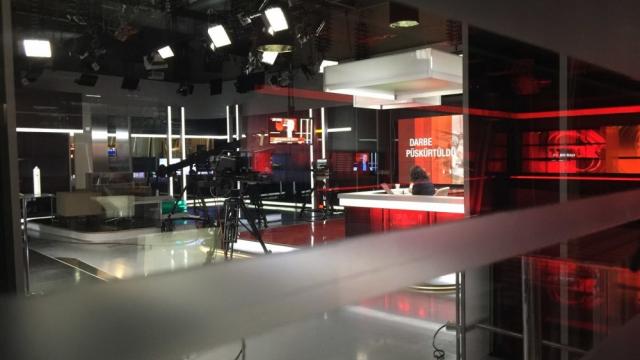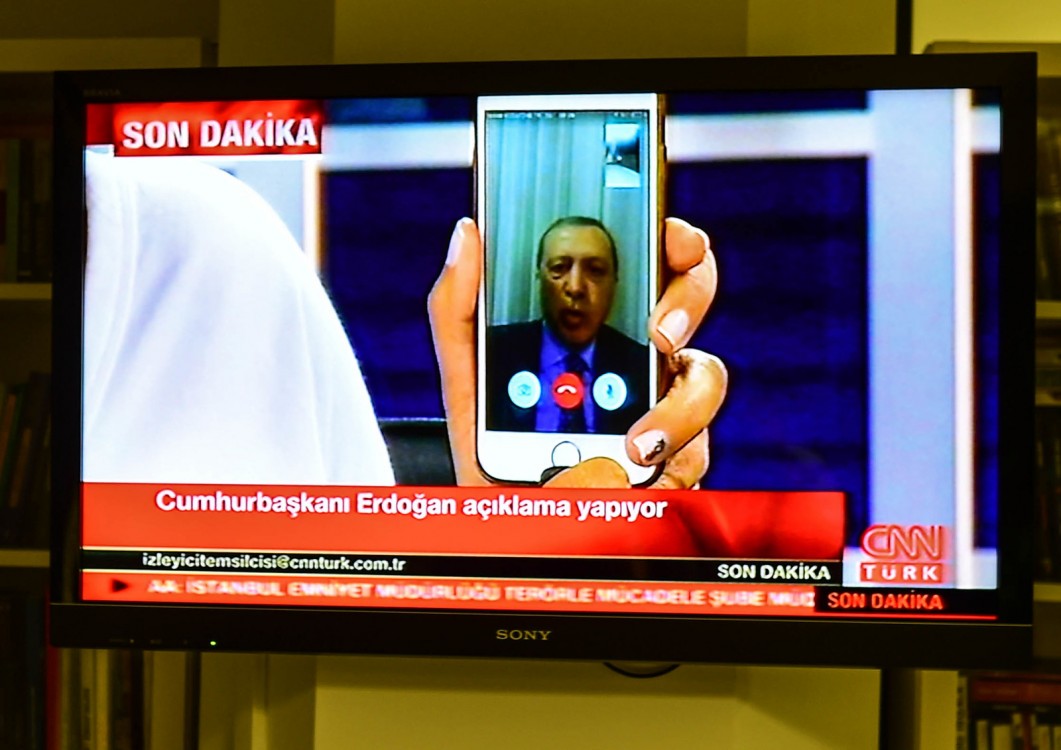
ISTANBUL — First came the army helicopter, filled with soldiers who fanned out and tried to seize control of the television station. Next came police in bulletproof vests with assault rifles, who hurried into the offices of CNN Türk, seeking to arrest the soldiers. By the time a mob of 200 people calling “God is great” smashed its way into the station seeking to maul the young soldiers, it became clear to the staff of Turkey’s most-watched news channel that their suburban office park studio had become a key battleground for the larger conflict playing out in the streets of the country.
It was also really awesome television.
“CNN Türk’s ongoing broadcast boosted morale,” said Aliser Delek, a chief CNN Türk producer. “That’s why people say the coup was defeated on air.”
All throughout the night on Friday and early Saturday, the channel broadcast live on television and streamed online in real time. For nearly an hour, CNN Türk broadcast a live scene of an empty anchor’s chair with the sounds of people screaming and fighting in the background. That was when CNN International, France 24, the BBC, and even Iran’s Press TV began tapping into the live feed, broadcasting the surreal events to a world struggling to understand what was going on.
Prime Minister Binali Yildirim’s announcement that a coup was underway came shortly after 11 p.m. He confirmed that the tanks blocking the bridges over the Bosphorus in Istanbul and the F-16s flying low over the capital, Ankara, were part of an attempt by armed forces to topple the government.
It was Delek who wrote the chyron that said, quoting the prime minister, “This is a coup.” “At that moment,” Delek told BuzzFeed News at an interview inside a conference room at CNN Türk’s offices shortly after the failed coup, “my hand was shaking.”
About 20 minutes later, the putschists sent an email to journalists announcing their intentions. “Turkish armed forces have completely taken over the administration of the country to reinstate the constitutional order, human rights and freedoms, the rule of law, and the general security that was damaged,” the note read.
Many of the dozens of journalists at CNN Türk in those hours were running on adrenaline, already exhausted and sleepless from covering the truck attack in Nice the night before. The gravity of the coup didn’t sink in until their anchor in the capital Ankara, Hande Firat, managed to get through on the phone to Erdogan at around 12:30 a.m. He hadn’t granted CNN Türk an interview in years. But now, suddenly, he accepted the request. Firat spoke to him as she held her iPhone aloft, his shaky image visible as he urged supporters to head into the streets and take control of airports.
That interview was described by some observers as the turning point. “Soldiers were out and it was very dangerous to call on them to go into the streets,” said Delek. “But if he had called on people to stay calm and in their homes, what would have happened?”
Shortly after 3 a.m., about five hours into the attempted coup, newsroom staff began to hear the roar of a helicopter coming closer and closer. Delek left the control room and drew away the curtains shielding the windows overlooking the parking lot. The Sikorsky chopper appeared dangerously close to the building. “We could see the face of the pilot in the helicopter,” said Alpaslan Akkus, an editor at CNN Türk, which is partially owned by Turner Broadcasting Systems, the parent company of CNN.
The helicopter landed in a clearing near the office complex, which also houses the daily Hurriyet newspaper and the Kanal D news and entertainment channel. They’re all part of the media empire of the Dogan Holding Group. Erdogan and his allies have repeatedly sought to pressure its boss, Aydin Dogan, into giving the government less critical coverage.
Last summer, amid a tense parliamentary election campaign, supporters of Erdogan twice stormed the offices of Hurriyet for being critical of the government. Critics say over the last eight months, Dogan media properties have begun to soften their coverage of the president and give less airtime to his critics.
“Any change in the political atmosphere affects the politics of the media, all the time,” said one CNN Türk journalist, who didn’t want his name used.
But as the soldiers began to fan out, many of CNN Türk’s exhausted staff put their politics aside and steeled themselves to resist.
Recep Capci, a security guard at the building, said soldiers who entered the building demanded he hand over his Kalashnikov assault rifle. He refused and instead called the police. “If they took my gun and used it to kill someone, I would be the one responsible,” he said.
“I called my wife, and said soldiers are about to arrive here,” said Erdogan Aktas, the station manager. “I told her to be calm and get the kids away from the television.”
An official in government praised the actions of CNN Türk and the choices made by Turkish news channels, including those considered critical of Erdogan. “All major TV channels took a common stand against the coup,” said a government official in Ankara, who was not authorized to speak to reporters. “It speaks volumes about the fact that we might have our disagreements but we all cherish democracy. People thought: We’ll fight side by side today so that we can mock each other tomorrow.”
Aktas had drawn up a plan in case putschists or anyone else tried to shut down the broadcaster. He would have a technician input a code into the control room that would make it impossible to stop the live feed. Even if they knew how to operate a television news control room, they wouldn’t be able to shut off the live feed. He also would instruct journalists to use Facebook Live to stream video directly onto CNN Türk’s page, which has more than 1.4 million followers.
Once the putschist soldiers entered the building and ordered CNN Türk employees to cut off the live broadcasts, the journalists banded together to keep the broadcast going, or at least delay their entry to give Aktas time to put his plan into play. A confrontation ensued. “They were screaming, ‘Leave the building. Cut the broadcast,’” Akkus recalled. “We were saying, ‘This is wrong. You must leave.’”
The young soldiers, who looked like draftees, clearly didn’t know what they were doing, or even that the CNN Türk offices were on the building’s third floor, something they could have learned from a Google search. “They were scared,” said Delek. “They were 20 or 21 years old and holding big guns.”
An army officer — their commander — soon arrived. Witnesses said he, in comparison, knew exactly what he was doing. He immediately took the soldiers to the third floor and asked for the control room and demanded that everyone leave the building. “We understood it wasn’t right to resist anymore,” said Delek. “For the sake of safety, we told everyone to leave.”
But the broadcast continued live. Aktas had also connected himself to a wireless microphone, so he could give the audience live updates. Millions of people could see an empty studio and hear Aktas’s voice. “Now the soldiers have arrived,” he explained. “Now they are ordering us out.”
Armed with assault rifles, a contingent of cops soon arrived at the CNN Türk building, demanding that the soldiers hand over their weapons (police mostly stayed loyal to the government throughout the coup attempt). The soldiers were reluctant to comply. Suddenly a mob of 200 angry pro-Erdogan supporters arrived, demanding to enter the station and take the soldiers away. CNN Türk journalists were under no illusion that the crowd was there to uphold media rights.
“There were a lot of fascist-motivated young people,” said one CNN Türk journalist. “I knew they weren’t here to defend us, because a year ago they were here to attack Hurriyet. They were angry at us, too.”
Suddenly, a shot rang out in the building, striking the glass atrium above the lobby. Pandemonium erupted. Video showed utter chaos as cops sought to arrest the soldiers, and angry men leaped over desks inside the second floor of Kanal D to pummel the soldiers.
“Police, soldiers, angry people, guns,” said Delek. “At that point, I became afraid.”
Police eventually cleared the building. Aktas informed the remaining crew shortly after 4 a.m. that they would continue the normal broadcast. But no one could find an anchor.
So he himself took the chair. Almost 36 hours after the coup attempt, the second floor of the building, where police, soldiers, and the lynch mob had clashed, was under repair, with construction workers hammering and drilling. The entire experience taught the CNN Türk the importance of keeping the cameras rolling no matter what.
“Even if soldiers, police and angry people arrive we had to keep going,” said Delek, 36, a philosophy student who has also worked as foreign correspondent for Al Jazeera and Turkey’s TRT news channels. “I understood that we were doing the right thing. It proved that journalism is essential for a democracy.”
3 WAYS TO SHOW YOUR SUPPORT
- Log in to post comments













Comments
anonym replied on
So WTF Is This, A Tribute To The Deluded Public Under Erdogan?
Seriously, why not go whole hog if you really want to adopt Erdogan propaganda? I'm sure his utterly undemocratic, in-fact-fascist regime would be happy to oblige you with thrilling footage of the people rising up against the coup.
What is wrong with the editor of this rag to include this slobbering pro-Erdogan drivel?
peterstrong replied on
was looking for this
was looking for this information, I will add this site to your favorites http://www.192-168-1-1.co